|
|
| Persepolis
Persepolis was the ceremonial capital of the Achaemenid Empire (ca. 550–330 BC). Persepolis is situated 70 km northeast of the modern city of Shiraz in the Fars Province of modern Iran (ancient Parse). Founded by Darius the Great around 518 B.C., looted and burned by Alexander in 331–330 B.C. The site includes a 125,000 square metre terrace, partly artificially constructed and partly cut out of a mountain. Major tunnels for sewage were dug underground through the rock and a complex system of water channels and drainage was cut into the rocky terrace. Several palaces were then built on the terrace.
King
Darius the Great 'invented' Persepolis as the splendid seat of the government of the Achaemenid empire and as its center for receptions and festivals. The wealth and might of Persia was to be visible in every aspect of its construction. Persepolis was a showcase. UNESCO declared the citadel of Persepolis a World Heritage Site in 1979.
To see the plan of Persepolis with the photo points marked on it with red dots click here!
|
|
Currently 21 panoramas in this collection
|
|
Persepolis Overview
Overview of the Perseplis from the eastern tophill just under the royal tomb av king Artaxerxes II (Ardashir II).
2013-05-13
Show on map
|
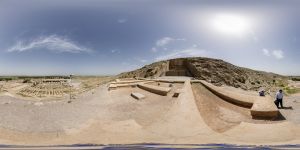
Persepolis Overview
Fullscreen
|
|
Persepolis - The Great Stairway
(#1) The construction of the large Stairs of All Nations in Persepolis was ordered by king Xerxes (486-465), the son and successor of the founder of the city, Darius I the Great. Originally, the main access had been in the south; now, one had to ascend to the terrace from the west.
The Grate Stairway of Persepolis is a monumental double-ramped stairway, which was designed in such a way that one could only proceed slowly and with dignity, because you are forced to walk upright.
2013-05-13
Show on map
|
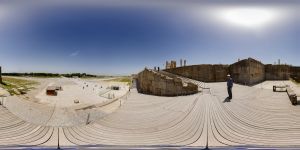
Persepolis - The Great Stairway
Fullscreen
|
|
Persepolis - The Gate of All Nations - west
The Gate of all Nations, referring to subject nations of the empire, consisted of a grand hall that was a square of approximately 25 metres (82 ft) in length, with four columns and its entrance on the Western Wall (here!). There were two more doors, one to the south which opened to the Apadana courtyard and the other opened onto a long road to the east (the Processional Way). All people from all subject nations had to go through this gate to enter the palace complex.
2013-05-13
Show on map
|
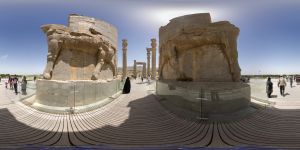
Persepolis - The Gate of All Nations - west
Fullscreen
|
|
Persepolis - The Gate of All Nations - east
While Persians and Medes had the privilege to take the south door directly towards Apadana, all the other subject nations were supposed to use the eastern door (here!) to the Processional Way to approach the Throne Hall. A pair of Lamassus, bulls with the heads of bearded men, stand by the western threshold. Another pair, with wings and a Persian head, stands by the eastern entrance (here!), to reflect the Empire's power.
To the left of the gate, the Apadana courtyard & its northern stairs can be seen.
2013-05-13
Show on map
|
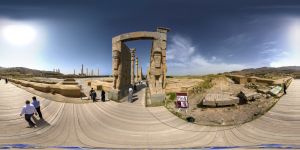
Persepolis - The Gate of All Nations - east
Fullscreen
|
|
Persepolis Overview. Processional Way
An Overview over the Perseplois at the end of the Processional Way, just before the the Unfinished Gate. To the right, off the Processional Way, two seemingly unused capitals can be seen, they are in the form of Griffins (eagle headed lions). Further away the Gate of All Nations. Another well preserved capital is seen on the ground just between the photo position and the unfinished gate.
2013-05-13
Show on map
|
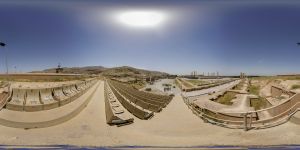
Persepolis Overview. Processional Way
Fullscreen
|
|
Persepolis - The Bull Gate
The Bull gate of the Hall of 100 columns. It is located in the courtyard between the unfinished gate (can be seen here) at the end of the Prcessional Way and the Hall of 100 Columns (The Throne Hall).
Two massive bulls guarded the hall entrance, one of them can be seen in this panorama, another one of them (undamaged) now in Chicago's Oriental Institute. That bull and a few digital reconstructions can be seen here.
2013-05-13
Show on map
|
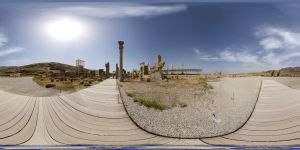
Persepolis - The Bull Gate
Fullscreen
|
|
Persepolis - The Throne Hall Main Entrance
The Main Entrance of the Throne Hall (The Hall of Hundred Columns). There was a portico at this entrance decorated with two colossal bulls (one can be seen here).
The entrance itself is decorated with 5 rows of Persian and Mede soldiers and on the sixth row the king on the throne in audience.
2013-05-13
Show on map
|
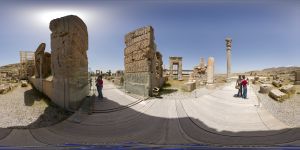
Persepolis - The Throne Hall Main Entrance
Fullscreen
|
|
Persepolis - The Throne Hall South Entrance
The south Entrance of the Throne Hall (The Hall of Hundred Columns). The entrance itself is decorated with 3 rows of people from different nations carrying the king sitting on his throne over their heads in the highest row. showing the positon of the king and all the other nations in the empire.
Through the gate the Harem's building can be seen with a bull capital in front of its entrance. It is used as a museum today.
2013-05-13
Show on map
|
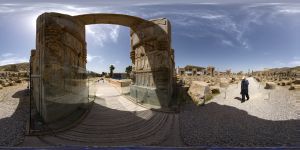
Persepolis - The Throne Hall South Entrance
Fullscreen
|
|
Persepolis - The Throne Hall
The Throne Hall or the Palace of hundred Columns, the second largest building at Persepolis (70x70 square metres). It had 100 columns supporting the roof. In the beginning of Xerxes's reign, the Throne Hall was used mainly for receptions for military commanders and representatives of all the subject nations of the empire. Later the Throne Hall served as an imperial museum/treasury as the gold and other treasures had grown so much that the original treasury's space had not been enough and part of the treasures were moved and kept here.
2013-05-13
Show on map
|
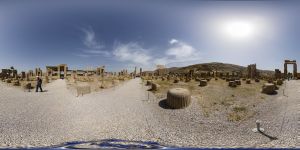
Persepolis - The Throne Hall
Fullscreen
|
|
Persepolis - The Throne Hall #2
Another view of the Throne Hall or The Palace of hundred columns. The Throne Hall or the Palace of hundred Columns, the second largest building at Persepolis (70x70 square metres). It had 100 columns supporting the roof. In the beginning of Xerxes's reign, the Throne Hall was used mainly for receptions for military commanders and representatives of all the subject nations of the empire. Later the Throne Hall served as an imperial museum/treasury as the gold and other treasures had grown so much that the original treasury's space had not been enough and part of the treasures were moved and kept here.
2013-05-13
Show on map
|
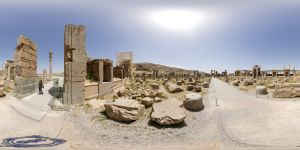
Persepolis - The Throne Hall #2
Fullscreen
|
|
Persepolis - Apadana Palace - Western Portico
The Apadana Palace, the greatest of all palaces in Persepolis, built by Darius the Great. The palace had a grand hall in the shape of a square, each side 60 metres (200 ft)long with seventy-two columns. Thirteen of which still stand on the enormous platform. Each column is 19 metres (62 ft) high with a square Taurus and plinth. At the western, northern and eastern sides of the palace there were three rectangular porticos each of which had twelve columns in two rows of six. The position of camera for this panorama is on the western portico just at the entrance to the main hall. A digital reconstruction of Apadana Palace can be seen here.
2013-05-13
Show on map
|
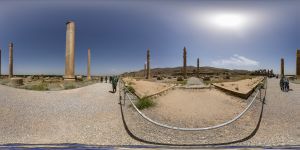
Persepolis - Apadana Palace - Western Portico
Fullscreen
|
|
Persepolis - Apadana Eastern stairs - Center Wall
The central scene of the relief of Apadana's eastern stairs. There are eight soldiers, Persians and Medes. The Persians belong to the regiment of "Immortals". They are ready for battle, carrying a sword, spear, and shield. Above them is a traditional representation of a winged sun, flanked by two sphinxes. A digital reconstruction of Apadana Palace can be seen here. 2013-05-13
Show on map
|
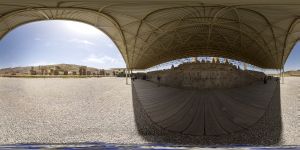
Persepolis - Apadana Eastern stairs - Center Wall
Fullscreen
|
|
Persepolis - Apadana Eastern stairs - Southern Wall
The eastern stairs of the Apadana at Persepolis with excuisite stone relief that miraculously survived the sack of Persepolis by the soldiers of Alexander the Great in 330 BCE.
The relief consists of three parts: the northern wall, with representations of Achaemenid dignitaries; the center, with eight soldiers;
and the southern wall (seen here), show a procession of people from different subject nations bringing tribute to the Achaemenid king, Darius the Great (r.522-486). A digital reconstruction of Apadana Palace can be seen here.
2013-05-13
Show on map
|
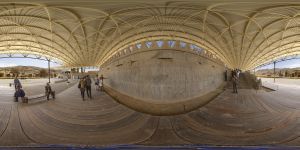
Persepolis - Apadana Eastern stairs - Southern Wall
Fullscreen
|
|
Persepolis - Tripylon Palace - Northern Stairs
The Tripylon ("triple gate") Palace of Persepolis can be found between the Apadana and the Hall of Hundred Columns. To the north of the building is a flight of stairs (seen here), decorated with guardsmen. If you descend the stairs, you're close to the Eastern stairs of the Apadana. You can see a digital reconstruction of this facade here.
2013-05-13
Show on map
|
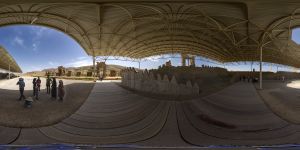
Persepolis - Tripylon Palace - Northern Stairs
Fullscreen
|
|
Persepolis - Xerxes Palace
Actually this is spot north of Xerxes Palace (Hadish) in an area between Xerxes and Darius Palace, but also between Apadana and Tripylon.
2013-05-13
Show on map
|
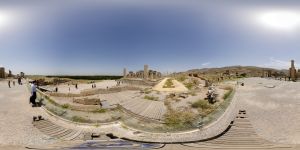
Persepolis - Xerxes Palace
Fullscreen
|
|
Persepolis - Darius Palace - Tachara
This palace was one of the few structures that escaped destruction in the burning of the complex by Alexander.
The Tachara, measuring 1,160 square meters (12,486 sq. feet), is the smallest of the palace buildings in Persepolis. Its main room is a mere 15.15m x 15.42 m (49.70 ft. x 50.59 ft.) with three rows of four columns.
2013-05-13
Show on map
|
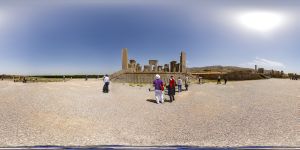
Persepolis - Darius Palace - Tachara
Fullscreen
|
|
Persepolis - The Royal Tomb
The Royal Tomb of Artaxesxes II, cut into the mount. As is customary, the relief on the upper part of the tomb shows the king sacrificing to the eternal, sacred fire and the supreme god Ahuramazda. He is standing on a platform that is carried by people that represent the subject nations.
2013-05-13
Show on map
|
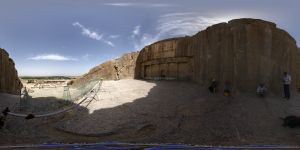
Persepolis - The Royal Tomb
Fullscreen
|
|
Audience Hall Stone Relief - Archeologial Museum
Audience Hall from the time of King Darius I the Great or Xerxes I.
The king sitting on his elevated throne (Note that his feet do not touch the earth), the crown prince directly behind him (larger than anybody else only second to the king to show his rank in the empire). Behind him a Zoroastrian high priest, next the king's weapon bearer and at last two royal guards (so called Imortals). In front of the king, two incense burner, the Palace mayor greeting the king in process of requesting permission to begin the audience and two more men, the first bearing a metallic incense burner and the second another guard from the Imortal regiment. This relief was found in the royal treasury of Persepolis, currently in the National Archaeological Museum of Tehran.
2013-05-13
Show on map
|
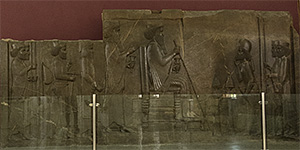
Audience Hall Stone Relief - Archeologial Museum
Fullscreen
|
|
Tirpylon Southern stairway - Archeologial Museum
The southern staircase of Tripylon carved out of one piece of stone. A man-bull column capital and a lion column capital in glass. Also a bronze pedestal of three lions, found in the treasury. Further away a upper part of a column from the Apadana Palace and stone dog. The last two items and detail from the stairway can also be seen here, currently in the National Archaeological Museum of Tehran.
2013-05-13
Show on map
|
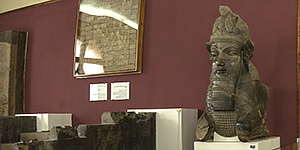
Tirpylon Southern stairway - Archeologial Museum
Fullscreen
|
|
Stone Statue of Darius the Greate - Archeological Museum
Stone Statue built during Darius the Great reign in Egypt, later moved to Persia, found in the Palace of Susa.
On the statue is written in hieroglyphic script:
"A great god is Ahuramazda, who created this earth, who created that sky, who created man, who created happiness for man, and who made Darius king.
This is the statue, made of stone, which Darius ordered to be made in Egypt. This is how everyone who will see this in the future, will know that the Persian man ruled in Egypt.
I am Darius, the great king, king of kings, king of all peoples, king in this great earth far and wide, the son of Hystaspes, an Achaemenid.
King Darius says: May Ahuramazda protect me and what I did! "
On the sides of the stone base there are long lists of all nations/countries that are under the rule of the Persian empire.
2013-05-13
Show on map
|
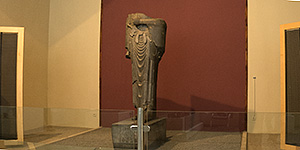
Stone Statue of Darius the Greate - Archeological Museum
Fullscreen
|
|
Ministry of Foreign Affair - Apadana Lookalike
A Persepolis inspired modern building, the Ministry of Foreign Affairs in Tehran. A clear copy of the palaces in Persepolis with double ramped stair ways, portico in the center of the facade, high stone columns with double bullheaded capitals, stone reliefs of Persian guards with spear. A simpler and smaller version of how the Persepolis and Susa Apadana palaces could look like. The ministry is in Bagh-e Melli (Meydan-e Mashgh) in Tehran.
2013-05-13
Show on map
|

Ministry of Foreign Affair - Apadana Lookalike
Fullscreen
|

